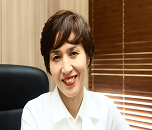Day 1 :
Keynote Forum
Giulio Maria Pasinetti
Professor
Keynote: Research of natural compounds: The crossroads between promotion of health and prevention of age-related neurodegeneration with polyphenols to avoid the catastrophic cliff of neuronal failure
Time : 09:30Am

Biography:
Giulio Maria Pasinetti is The Saunders Family Chair and Professor of Neurology, Psychiatry, Neuroscience, Geriatrics and Adult Development at the Icahn School of Medicine at Mount Sinai. He is also the Program Director of the NIH funded P50 Center on Molecular Integrative Neuroresilience focused on understanding the molecular mechanisms and pathophysiology that may be at the basis of stress-induced mood disorders, including anxiety, depression, and other neuropsychiatric disorders and their influence on cognitive dysfunction. He is the recipient of several academic awards, including the prestigious Zenith and Temple awards and the Foundation Queen Sofia of Spain Research Center Award on Alzheimer’s disease. Most recently, he received The Faculty Council Award for academic excellence at Mount Sinai School of Medicine and The Charles Dana Alliance for Brain Research Award from the Dana Foundation, recognizing productivity and worldwide leadership in his field of expertise. He is the recipient of more than 30 NIH federal, industry and non-profit organization research grants and has published over 300 groundbreaking manuscripts.
Abstract:
Polyphenols are a large and diverse group of naturally occurring compounds widely distributed in many plant-derived foods and beverages. Polyphenols are receiving increasing attention for their potential role in the promotion of resilience in response to stress-induced psychological impairment and cognitive deterioration. In particular, preclinical evidence demonstrated the efficacy of certain polyphenols, acting either individually or in combination, to modulate multiple diverse mechanisms relevant to depression and anxiety, which also pose a risk to neurodegeneration such as Alzheimer’s disease, implicating the potential for novel development of polyphenols for multi-target engagement. In spite of the increasing efforts committed to clinical testing of polyphenols, these efforts are hindered by limited knowledge of polyphenol bioavailability, specific forms of brain-bioavailable bioactive polyphenols (including polyphenol metabolites) and their underlying mechanisms of actions. The overall goal of this presentation is to provide an overview on the “state of the art” on the development of polyphenols and eventually their translation into the clinical setting. In particular, I will discuss the mechanistic implications of brain-bioavailable bioactive polyphenol metabolites in modulating key physiological processes that are relevant in preventative and therapeutic approaches to stress-induced psychological impairment and cognitive deterioration. Moreover, emerging evidence suggests that there is a pivotal role of the gastrointestinal microbiota in mechanisms associated with bioavailability of bioactive polyphenol metabolites. Based on this consideration, I will discuss novel evidence about the role of microbiota in modulating the bioavailability of bioactive phenolic acids from polyphenols. Collectively, in my presentation, I will critically discuss the current complex mosaic of evidence, which puts the investigation of brain-bioavailable bioactive polyphenols at the cross-roads between promotion of health and prevention of age-related psychological resilience and prevention of age related degenerative disorders.
Keynote Forum
Kyeong Mee Park
Medical Doctor
Keynote: Anti-mTOR activity of aqueous extract from roots of Acanthopanax senticosus
Time : 10:15

Biography:
Kyeong Mee Park has completed her PhD from Korea Advanced Institute of Science & Technology and Medical Doctor from Daejon University School of Oriental Medicine. She has investigated various pharmacological properties of herbs including ginseng and Chinese medicinal herbs for 13 years and published 24 papers in reputed journals. Also, she is interested in the acupuncture point injection with herbal medicine as a Medical Doctor and recently published 3 books and 6 papers. She is the Director of Inno Oriental Clinic as well as Fuzopuncture Institute.
Abstract:
The mammalian target of rapamycin (mTOR) signaling pathway couples energy and nutrient abundance to the expression of cell growth and division. mTOR is crucially involved in the onset and progression of diabetes, cancer and ageing. The screening of >2,800 natural plant products used for traditional medicine has selected an aqueous extract from roots of Acanthopanax senticosus (A. senticosus) as a natural product that modulates mTORC1 pathway. The plant extract inhibits mTORC1 activity, but presents low cytotoxicity in HeLa human cancer cells. Treatment of the root extract of A. senticosus resulted in the inhibition of mTORC1 activity as measured by the phosphorylation status of p70 S6 kinase (S6K) in HeLa cells and the induction of autophagy as assessed by the conversion of cytoplasmic LCI into lipidated LCII in HeLa GFP-LC3 cells stably expressing GFP-LC3. The treatment of HeLa cells with this plant extract also induces cell cycle arrest at G2/M phase. A strong therapeutic potential of A. senticosus extract that inactivates mTORC1 pathway has been suggested by showing the reduced level of phosphorylated S6K in tissues of 15-week-old diabetic obese db/db mice intraperitoneally injected with A. senticosus extract (100 µg/g body weight/day) for a week. Taken together, these results suggest that the aqueous extract of A. senticosus is a promising candidate for prevention of cancer, diabetes, and ageing by inhibiting mTOR signaling.
- Alternative Medicine-Advanced Treatments & Current Research; Acupuncture as an Alternative Medicine; Importance of Herbal Medicine

Chair
Giulio Maria
Chair
Session Introduction
Jeena N Janardhanan
Associate Professor
Title: Clinical trial to prove the efficacy of leech therapy in reducing the intra-ocular pressure in glaucoma patients

Biography:
Jeena N Janardhanan has completed her MD (Ay) from University of Kerala, India and presently doing her PhD at Tilak Maharashtra Vidyapeeth, Pune, India. She is presently the Associate Professor & HOD, Department of Head and Neck at VPSV Ayurveda College, Kottakkal, India (Kerala University of Health Sciences, India). She presented many papers in international conferences.
Abstract:
Raised intra-ocular pressure is seen in glaucoma which is very much prevalent all over the world. Controlling the IOP is a big task which presently involves some surgical measures. The prognosis of the disease is also not so good with the current treatment modalities. The aim of this study is to prove the efficacy of leech therapy in reducing the increased IOP. Even though the procedure is invasive, the risk and complications are minimal compared to other procedures. Open label clinical trial was conducted in 30 diagnosed patients of chronic open angle glaucoma with a raised IOP of more than 25 mm of Hcg. Leech therapy was done once in 3 days for a period of one month. Live healthy leeches of the family Hirudinae medicinalis were used for the study. IOP was assessed using indentation tonometer, before and after each sitting of the therapy. The data before starting the treatment and after one month were also compared. An average reduction of 5mm of hg intra-ocular pressure was recorded. The data analyzed statistically and found significant.
Eun-Tae Jo
Member of Korea Pain Dignosis Society
Title: Biomechanical approach related to meridians and myofascias: Biomechanical acupuncture

Biography:
Eun-Tae Jo has completed his PhD from Daegu-Haany University and is a member of Korea Pain Dignosis Society and has studied on back pain. He will present a poster at 9th Interdisciplinary World Congress on Low Back and Pelvic Girdle Pain in Singapore on 31st October 2016. He is the Co-author of “Shoulder treatment ABC”.
Abstract:
Biomechanical acupuncture originated from the biomechanical approach of treating musculoskeletal pains by Myofascial concepts of Western medicine and Meridian concepts of Traditional Chinese Medicine (TCM). There have been various attempts to treat musculoskeletal pains with needle stimulations around the East and the West. But practical point of views, most practitioners agree upon the difficulties in choosing exact treatment points. In this paper, a new concept of Biomechanical acupuncture is proposed to solve the difficulties, which is simple and easy to apply to everyday practice but enough to integrate modern myofascial concepts and traditional meridian concepts. In the basis of Biomechanical acupuncture, Myofascial concepts don’t mean trigger points but biomechanical network of anatomical myofascia. And Acupuncture points in TCM related to 12 Meridian theories are to be used in the treatment of musculoskeletal pains. Owing to ceaseless connection of the whole myofascia, a disorder in one region may be expressed in the form of pain and limitation on certain movement in other part of body mainly in the same myofascial tension line by biomechanical dysfunction. As a result, a cause of biomechanical dysfunction gets to be enlarged. Repeated stresses transcending the limited range give rise to a local inflammation or a pain. Biomechanical acupuncture doesn’t cure and heal anything. All it does set body back to normal so that healing process begins.

Biography:
Pei-Chen Lo has completed her PhD in 1990 from University of Florida, Gainesvill, FL, USA, majoring in Biomedical Signal Research (particularly, electroencephalograph EEG). She was the Research Associate in EEG Lab, University of Utah Medical Center from 1990 to 1992. She became an Associate Professor of Electrical Engineering at National Chiao Tung University in 1992 and a Full Professor in 2001. She began practicing Zen meditation with Patriarch Wu Jue Miao Tian in 1994 and started the research on Zen-meditation EEG and cardiorespiratory functions in 1998. She published more than 30 papers with respect to Zen-meditation physiological and mental states.
Abstract:
Holistic Detox Association (HDA) is a nongovernmental organization which provides various types of support for drug rehab. HDA offers a series of programs beneficial for addicts to get their lives back in order. Zen-meditation practice, one of the core programs, is a healing scheme via brain-mind reformation rather than conventional medication or behavior control. While the program was underway, we collected the meridian energy data of the participants before and after a 20-minute practice of Zen meditation offered by the orthodox Zen Sect, supervised by patriarch Wu Jue Miao Tian. The basic practice includes abdominal breathing and Mailun (particular energy spot) concentration to activate enormous good potency beneficial to the body and mind. The participants may accordingly refuse the drug and its negative effect on their own. Totally sixty-three participants (56 males and 7 females, age 21–57 years) were recorded. The participation in the experiment was completely voluntary. All participants signed the agreement form at their own free will. All procedures are consistent with the Declaration of Helsinki and were approved by the Institutional Review Board of National Chiao Tung University. Based on the Twelve Meridian theory, meridian energy data were recorded from 24 laterally symmetric acupoints. Preliminary results indicate 1) WuXing (five-element theory) efficiency and autonomic nervous system balance improve after Zen meditation, 2) group average of each meridian energy increases in 16 out of 24 meridians, and 3) more than one-half participants have the overall meridian energies increase (mostly, the energy of lung and pericardial meridian).

Biography:
Hilda Zhang is a health care innovator with over 40 years of experience in health and finances. Drawing from her rich expertise in financial management and wellness practices, she has formulated an interdisciplinary approach to wellness that is accessible to consumers. Through decades of research and practice, Hilda Zhang has developed SWNWT, a practical approach to individual health that can keep pace with the rapidly developing research landscape. The crux of SWNWT is its ambition to cultivate full health within people. The asymptomatic individual is inadequate. Hilda Zhang travels the world, actively refining SWNWT through continued research and practice.
Abstract:
Contemporary health care practices propagate a vicious cycle of symptoms, medications, and side-effects. Side-effects stemming from medication accumulate into chronic symptoms, which are in turn aggressively medicated. Through a lifetime of research and practice, Hilda Zhang has compiled and organized a wellness philosophy that shifts the paradigm of health away from this obsolete cycle. The interdisciplinary SWNWT (Self Wealth Nurture Wellness Technique) approach provides a much needed upgrade to our understanding and implementation of wellness maintenance techniques. The tenets of the SWNWT approach emphasize contextualized and holistic prognosis, finance-integrated investment analyses and continuous education and re-education to unify the individual with their own wellness maintenance. No doubt, advancements and innovations in technology and science have revolutionized quality of care and standards of living across all walks of life. The philosophies that accompany these developments are long overdue for their own revolution. The SWNWT approach is the precursor to this revolution, whereby the script is flipped, and health care ceases to be a haphazard reaction to symptoms of poor lifestyle. The SWNWT approach bridges an important rift between consumer understanding and wellness autonomy, delivering clients the tools to master their own wellness futures.
Xiaofeng Zhao
Director of Chinese association of acupuncture
Title: Should complementary therapies be used to lowering blood pressure in adult hypertensive? A grade of quality of evidence and strength of recommendations

Biography:
Xiaofeng Zhao has completed her MD at Tianjin University of Traditional Chinese medicine. She is the Chief Doctor of the VIP ward of Acupuncture and Moxibustion in First Teaching Hospital of Tianjin University of Traditional Chinese Medicine, the Professor and the Supervisor of Post-graduate of Tianjin University of Traditional Chinese Medicine. She has been researching on the therapeutic mechanism of stroke and hypertension by acupuncture for decades and published over 50 papers in reputed Chinese and English journals. She is the Director of the council of bloodletting and cupping of Chinese association of acupuncture and the member of the innovation research team of Chinese Ministry of Education.
Abstract:
Objective: The purpose of this work is using GRADE approach to rate the quality of evidence in systematic reviews which examined complementary therapies’ efficacy and safety for lowering blood pressure and evaluating the strength of recommendation in order to determine that should complementary therapies be used to lower blood pressure in adult hypertensive.
Method: Six electronic databases and the reference lists were searched for eligible systematic reviews. Characteristics of included reviews, results of meta-analysis, assessment of methodological quality and risk of bias of studies were collected and AMSTAR score were used for rating the methodological quality of included systematic reviews. GRADE approach was used for grading the quality of evidence and strength of recommendations. Evidence used to evaluate the strength of recommendation was only collected from comparisons between complementary therapies and antihypertensive drugs.
Results: 9 interventions were included in the qualitative synthesis. Quality of evidence in all included systematic reviews, were assessed, and they were generally not high. Only systematic reviews of Qigong, massage and acupuncture were used to make recommendation. The rigorous assessment resulted in a high recommendation pertain to Qigong and a weak recommendation to massage, whether they were used alone or in cooperate with other therapies. Acupuncture used alone was recommended to only use in research and used in coordination with antihypertensive drug was given a weak recommendation.
Conclusion: We thought that Qigong could be used to lower blood pressure in clinic, but massage and acupuncture plus anti-hypertensive drug should be used with caution.

Biography:
Joanna B Strosznajder obtained her MD and specialization in Neurology from Medical University of Warsaw and PhD in Biochemistry from Polish Academy of Sciences (PAS). After PhD, she spent 2 years as Alexander von Humboldt fellow at the Department of Biochemistry, University of Cologne. She is an internationally recognized Neuro Scientist in the field of brain lipids, oxidative stress and signaling pathways in relation to cancer, brain ischemia, aging and neurodegeneration. She was the Head of Dept. of Cellular Signalling and the President of Scientific Council in Medical Research Centre PAS. She is training a large number of students and graduates. She organized many meetings and published 200 articles. She has received many awards.
Abstract:
Poly(ADP-ribose) polymerases(PARPs) and Sirtuins (Sirts) are NAD+ dependent ezymes involved in regulation of energy homeostasis, genomic stability. The interplay between PARPs and Sirts is crucial in brain ischemia, Alzheimer’s Disease (AD) and other neurodegenerative disorders .Our recent study focused on the role of these enzymes in toxicity of amyloidogenic protein: amyloid beta (AB) and alpha synuclein (ASN) the key players in pathomechanism of AD. Our data indicated that inhibition of PARP-1-leads to activation of gene expression for Sirt1 and mitochondria Sirts (3,4,5) in PC12 cells. The inhibition of PARP-1 downregulated expression of beta secretase (BACE-1) the crucial enzyme in amyloidogenic metabolism of AB precursor protein (APP). This amyloidogenic pathway is activated by extracellular AB42 and ASN which upregulated expression of BACE-1 and also the subunits of secretase gamma. AB and ASN oligomers decreased the signaling pathways regulated by sphingosine kinase-1 and Akt kinase leading to apoptosis. Concomitantly, inhibition of Sirt1 and activation of genes for mitochondria Sirts and DNA bound PARPs occurred. Resveratrol and quercetin protect small population of cells against AB toxicity therefore it is a big request for the novel phytochemicals. We hope that PARPs and Sirts are very promising targets for novel therapeutic strategy of neurodegenerative disease.

Biography:
Giulio Maria Pasinetti is The Saunders Family Chair and Professor of Neurology, Psychiatry, Neuroscience, Geriatrics and Adult Development at the Icahn School of Medicine at Mount Sinai. He is also the Program Director of the NIH funded P50 Center on Molecular Integrative Neuroresilience focused on understanding the molecular mechanisms and pathophysiology that may be at the basis of stress-induced mood disorders, including anxiety, depression, and other neuropsychiatric disorders and their influence on cognitive dysfunction. He is the recipient of several academic awards, including the prestigious Zenith and Temple awards and the Foundation Queen Sofia of Spain Research Center Award on Alzheimer’s disease. Most recently, he received The Faculty Council Award for academic excellence at Mount Sinai School of Medicine and The Charles Dana Alliance for Brain Research Award from the Dana Foundation, recognizing productivity and worldwide leadership in his field of expertise. He is the recipient of more than 30 NIH federal, industry and non-profit organization research grants and has published over 300 groundbreaking manuscripts.
Abstract:
Background: There is increasing evidence supporting a protective role of intestinal microbiota against diverse medical conditions, including neurological disorders such as Alzheimer’s disease (AD) by modulation, in part, of metabolic and immune responses. For example, gut bacteria metabolize soluble dietary fiber into biologically available short chain fatty acids (SCFAs) that may help modulate immune responses in the periphery and in the brain. Gut bacteria are also known for their role in converting dietary polyphenols into biologically available phenolic acids with anti-oxidant activities. However, there is little information on the potential role of SCFAs
and phenolic acids in Alzheimer’s disease. The present study is designed to investigate effects of these SCFAs and phenolic acids in beta-amyloid (Aβ)-mediated pathologic processes that play key roles in AD pathogenesis.
Methods: In in vitro studies using multiple complementary assays, we investigated individual SCFA and phenolic acid that are generated by GI microbial metabolism of dietary fiber and polyphenols for their dose-responsive effects in interfering with the assembly of Aβ peptides into neurotoxic soluble Aβ aggregates. We also investigated in vitro effects of isolated human GI bacteria in converting dietary fibers and select polyphenol products into biologically available SCFAs and phenolic acids that are effective in inhibiting Aβ aggregation.
Results: We found several phenolic acids that potently inhibited Aβ aggregation. We also found significant differences among GI microbiota from different healthy human donors in converting dietary polyphenols into these bioactive phenolic acids and in further metabolic degradation of these phenolic acids. Ongoing studies are investigating effects of individual SCFAs in Aβ aggregation and the efficacy of GI microbiota from different human donors in the generation (and degradation) of these SCFAs.
Conclusions: Intestinal microbiota may help protect AD, in part, by supporting the generation of phenolic acids and SCFAs that interferes with the formation of toxic soluble Aβ aggregates. Presence of interpersonal differences in the human gut microbiota may lead to interpersonal variation to benefit from the protective effects of dietary fiber and polyphenols in AD. Outcomes provide critical information for developing probiotics to help prevent and/or treat AD.
Learning Objective:
Demonstrate important mechanisms by which intestinal microbiota may help protect against AD.
- Alternative Medicine Market and Future Scope in China; Traditional Chinese Medicine; Naturopathic Medicine

Chair
Kyeong Mee Park
Chair
Session Introduction
Seonghyung Cho
pain specialist
Title: Evaluation of new treatment about sacral torsion: Joint energy technique (JET)

Biography:
Seonghyung Cho graduated from the College of Medicine, Chosun University for MD in 1999 and then graduated from the College of Oriental Medicine, Daejun University for OMD. Currently, he has active clinical practice as pain specialist in Joint & Spine Clinic Center, Gwangju, Korea with specialty in the use of manipulative therapy and biomechanical acupuncture for musculoskeletal problems. He has published 5 books about musculoskeletal pain and delivered numerous seminars introducing the diagnosis and treatment of musculoskeletal pain. He devised his concepts; Functional Orthopedic Stimulation Therapy (FOST) including Joint Energy Technique (JET), Shoulder Capsular Approach, Biomechanical Neural Mobilization, Biomechanical Acupuncture, etc.
Abstract:
Introduction: Sacroiliac joint dysfunction (SIJD) is a significant cause of low back pain (LBP). SIJD is presumed to be due to biomechanical disorders and often presents with pelvic asymmetry causing pain and dysfunction. Muscle Energy Technique (MET) is utilized to correct pelvic asymmetry, inhibit pain, and improve disability in SIJD. But sometimes the patient in SIJD is in too much pain to contract a muscle or may be unable to cooperate with instructions or positioning. Moreover there are patients unable to be cooperative due to age, intellectual capacity during sacral MET. Thus this study introduces the new treatment of Joint Energy Technique (JET) to easily apply for SIJD relatively regardless of a patient's condition. A new concept of JET in SIJD is proposed to solve the difficulties, which is simple and easy to apply to practice.
Purpose/Aim: The aim of this study was to investigate whether the rotational direction of innominate altered after JET on sacral torsion problem in comparison with JET on neutral position and to confirm biomechanical recover of sacral torsion.
Methods: The 80 subjects in age group of 15-68 years with LPB were randomly assigned and confirmed as Left on left (LOL) sacral torsion with Seated flexion test and Stork test in right SIJ with ipsilateral foot pronation. The subjects were divided into two groups of 40 subjects. The first group (A) was given JET to recover LOL sacral torsion. In case of LOL sacral torsion, the sacral position is sidebent right, rotated left and right sacral base is anteriorly nutated. Thus the preparatory position of JET is the right lateral recumbent position with lumbar rotation to the left like MET. JET is performed by patient’s passive movement and practitioner’s active effort instead of patient’s isometric contraction such as MET. The second group(B) was given simply the preparatory posture of JET on neutral position for correction of LOL sacral torsion. Group (B) was not given the rotation correction by the practitioner’s force. After each JET, the subjects were confirmed with the change of Stork test in the right SIJ.
Results: This study revealed that there was statistically significant difference (P<0.001) in pre and post treatment of JET between both groups. The Stork test was changed from positive to negative in 37 subjects of group (A). In group (B), 6 subjects were changed from positive to negative.
Conclusion: A new concept of JET is simple and easy to apply to practice in the treatment of patients with SIJD. This trial is revealed that JET is significantly effective in correction of SIJD and sacral torsion. JET should be considered as an adjunctive intervention in SIJD treatment.
